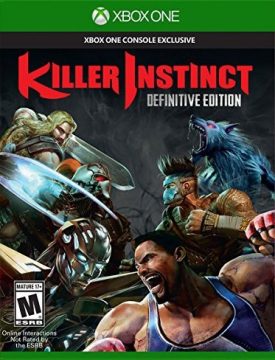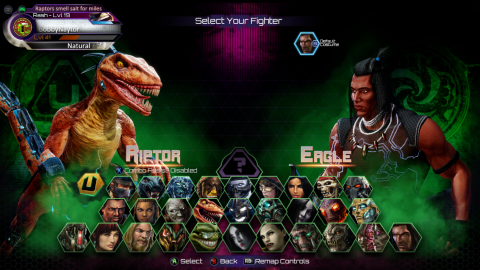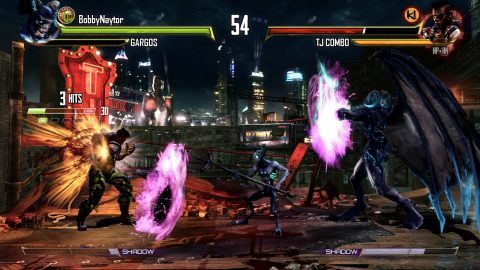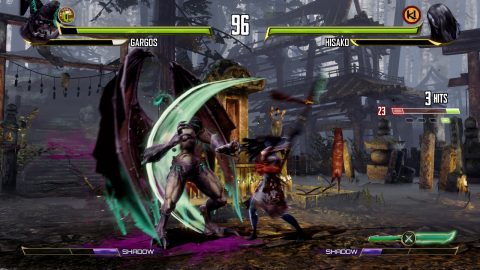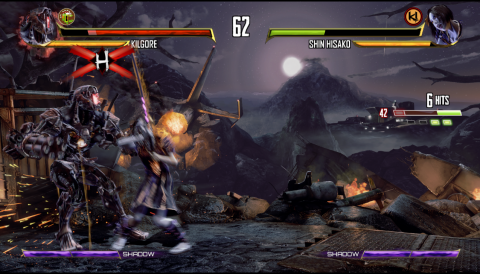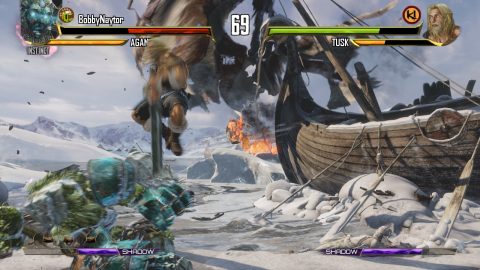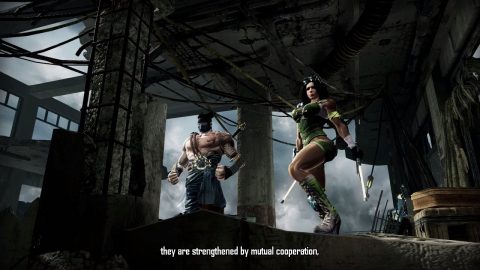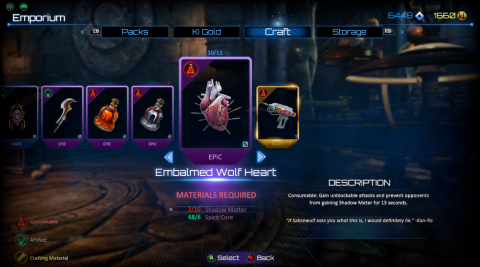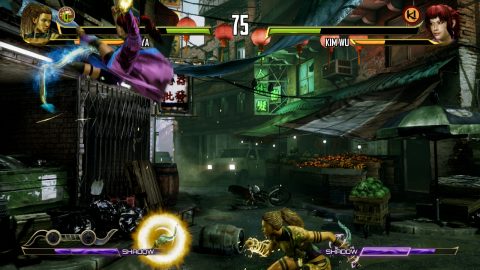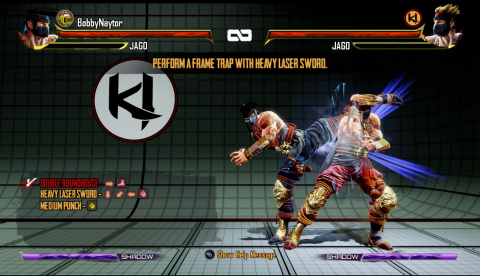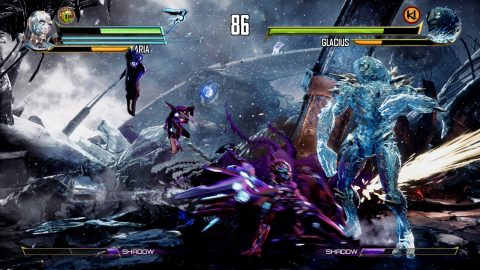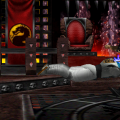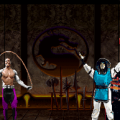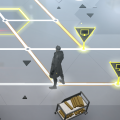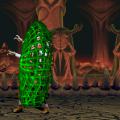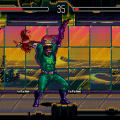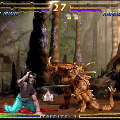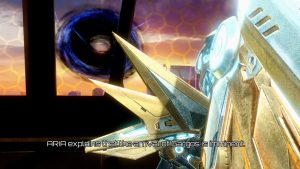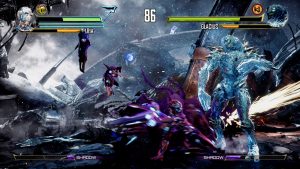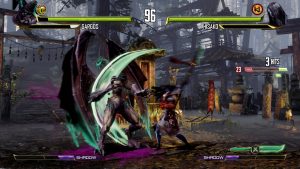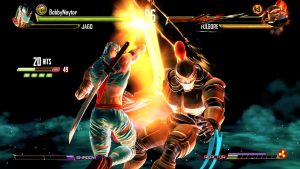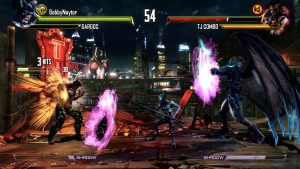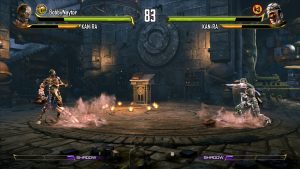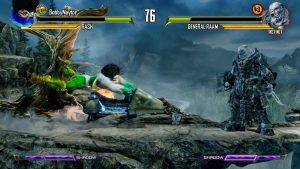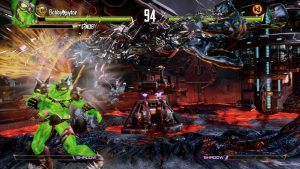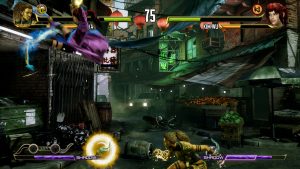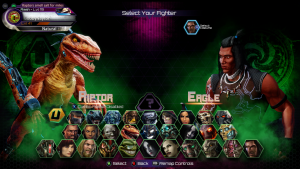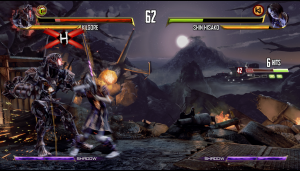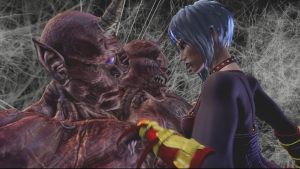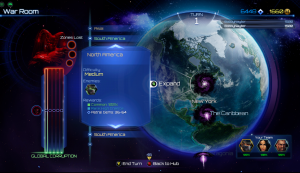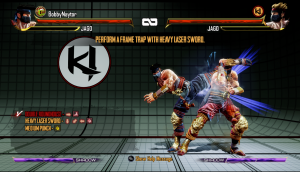- Killer Instinct
- Killer Instinct II / Killer Instinct Gold
- Killer Instinct (Reboot)
To be truthful, the Killer Instinct reboot (also known as KI2013) shouldn’t have ended up anywhere as good as it actually is, given the circumstances behind it. Initially developed by Double Helix, a company known for poor licensed games and some of the worst of the Silent Hill series, it saw exclusive release on a console that was, to put it simply, rather divisive. It didn’t help that it launched with only a paltry six characters, and no arcade mode. (Although, in fairness, it had one more single player mode than Street Fighter V started with, so it earns points for that.) Despite everything, however, after three years, a change in developer (Iron Galaxy Studios), and twenty more characters in its roster, KI2013 is a massive improvement on the games that preceded it in every perceivable way.
While some of the events that transpired in the previous two games still mentioned, this particular game is a complete rewrite of the story, such as it was. The game now takes place in the modern day, instead of some indeterminate point in the future, and there’s no longer any time travel weirdness. Ultratech are still a thing, and they’re still being jerks, making killbots, genetically engineering things, and messing with the resting places of vengeful spirits just to see what will happen. They’re no longer just generically evil, however, and are doing this to prepare humanity for the arrival of Gargos. All the cast have their own motivations, some seeking to take out Ultratech, some working for them, and some who are more interested in the bigger picture. It’s not as dense as the lore to, say, BlazBlue, but it’s not a complete excuse like the previous games, either.
The basic mechanics of the game have been given an extensive overhaul, with most of the odder mechanics like parries, transition moves, and the ability to recover from defeat having been spread out amongst the cast. The basic controls aren’t too dissimilar to Capcom’s Street Fighter IV, with a six button setup, two button throws, and a forward and back dash for every character. The shadow meter has been reworked into a two-bar system that powers a variety of different abilities. Shadow moves work somewhere between the EX and super moves of other fighters, offering better range, protection, and other helpful properties over regular special moves. Shadow Counters allow you to counterattack and launch into a combo, if you’ve got good timing. With one notable exception, the game doesn’t have any flashy, cinematic supers for instant damage, meaning that you generally have to think a lot more carefully about how you spend your meter.
New to the series is the Instinct meter, which fills up when a fighter takes damage, typically once per life bar. Activating Instinct not only cancels whatever your character’s currently in, allowing for tricky counterattacks and devastating combos, but it also activates a unique buff for each of the characters. Instinct typically takes something a character does well at and makes them even better at it. Orchid can instantly summon charging firecats to make it even easier to pressure her opponents, while Tusk can instantly cancel one special move to another. There’s never any Instinct that won’t be a great help, but they all take work to use effectively, instead of working as an easy comeback mechanic.
A character’s Instinct is far from the only thing that sets them apart, and KI2013 offers some of the most varied gameplay styles seen in a fighter. Every archetype you could ask for in a fighting game is covered here, from Sabrewulf’s tricky rushdown play, to General RAAM’s devastating throws. Once you move beyond that, however, you’ve got characters like Aganos, who can change the boundaries of the stage at will, or Eyedol, who constantly forces you to switch between two very different playstyles. While the movement, controls, and gameplay edges closer to Street Fighter, the variety of playstyles on display brings something like Guilty Gearcloser to mind.
The combo system still follows the same basic terminology, with openers, linkers, autodoubles, and enders all serving as the basic building blocks of a combo. It’s far less restrictive than it was in the past, since the timing on when you can perform the next move being far less strict. You’re also given far less rules to follow, with the only thing really restricting you is a meter that’ll drop your combo if you add too many hits. Autodoubles and linkers can be done at different speeds, with quicker moves building the meter faster, but are harder to break. If you really want to confuse your opponent, you’ll want to add a Manual to your combo, a well-timed single hit which works like the ‘links’ seen in other fighters. Finally, any special move can now be used to end your combo, and each character’s ender offers a different benefit. Try a combo ending with Jago’s Endokuken for a boost to your shadow meter, or end with his Wind Kick to smash the opponent against the wall, throwing off their timing and opening them up for further hits.
Every character also has one unique trait that sets their combos apart. Jago, for example, can perform multiple autodoubles in a row by hitting buttons of descending strength, while Glacius can continue a combo from any distance from his opponent. If you can put all these techniques together, you can put together some massive combos that will constantly keep your opponent guessing on just what you’ll do next. Cinder, for example, excels at juggling, using detonatable bombs and aerial attacks that stay well out of the usual combo routine. While you can do well enough following the basic rules of linkers and autodoubles, there’s plenty of room to be creative and keep your opponent guessing on what you’ll do next. Once you get used to the general rhythm, it’s far more interesting than what amounted to following a flowchart in the previous games, especially with so fewer regulations to constantly keep in mind.
Even the most basic combo is still capable of wiping out half your life bar, so knowing how to combo break effectively is more important than ever. This time around, it’s as simple as pressing two buttons of the same strength as the opponent. Shadow linkers can also be broken, requiring you to hit two buttons at the moment each hit of the move hits you. It’s something not too unlike the parries seen in Street Fighter III, and since the rhythm on shadow linkers can vary wildly, it’s always something you’ll need to pay attention to. In a particularly nice change, performing a breaker only sends the two distance about a jump’s distance away from each other, putting them in a neutral state. It’s a nice touch that means that no matter how often breakers occur during the match, it always means the two characters can go right back to battling without a moment’s pause.
The biggest change is that combo breaking isn’t nearly as invincible as it used to be, and if you mistime a breaker, or use the wrong strength, you’ll suffer a Lockout, and won’t be able to break for three seconds. While it’s certainly possible to guess at which strength an opponent is using, this is pretty risky, there’s always enough of a tell to make an educated guess. Different autodoubles make distinct sounds and draw different reactions from the opponent, while linkers of different strengths vary in their number of hits. This means the offense is going to want to do anything they can to try and prevent their combo from becoming too obvious, such as launching their opponent and using a special move to bring them back to the ground, disrupting the defense’s timing. Should you deal with an opponent who’s especially good at breaking, there’s always the ever-risky Counter Breaker. You can drop your combo at any time to go into a defensive pose, and should your opponent try to break, they’ll suffer a four second lockout, giving you free reign to unleash your nastiest combo upon them without retribution. It’s incredibly risky, since it leaves you wide open to counterattack, but doing it right is satisfying beyond words.
The new combo mechanics basically turn the game into a constant two-way mind game, a game where knowing your opponent can be just as useful as knowing your character. Any fighting game can give you flashy combos, but rare is the one that can allow an opponent to use one against you. At times, it feels more like a high-stakes game of poker than a fighting game, one where you always have to know just how far you can press your opponent before they’ll get their chance to counterattack. The fact that players always have control of the match, no matter the situation, is what makes KI2013 truly unique. You’re given almost no breaks in the action, and precious few moments you can afford to move your hand from the buttons, on either offense or defense. There may be other fighting games that offer more speed, but you may find none that offer the sheer, sweating intensity that this game offers.
That intensity is just a small part of just how fun KI2013 is to play, however. The general pacing is far quicker than recent Street Fighter titles, with most characters quickly able to close the distance, and more focus on offensive play. Matches can play out incredibly quickly, especially with how severely momentum can switch back and forth between two skilled players. The sheer variety between characters helps as well, as it’s always interesting to see the way the different things the fighters can do interact with one another. Despite its depth, it’s also a very approachable game, with even the most damaging of grabs being performed with a simple quarter motion, as opposed to the half circles, double quarter circles, and 360 motions of competing games.
The traditional Ultra Combo is always there for you when you finish a match, now with the added touch that each one is a musical sequence of hits, with each of the game’s tracks providing the instruments. Should you hate your opponent enough, it’s possible to pop your instinct and unleash a second Ultra, with some characters capable of even more beyond that. Thankfully, Ultras can now be skipped as well, ending the animation and the match with a single powerful hit. Only a portion of the cast still have Ultimates, which, while not nearly as goofy as those seen in previous games, only rarely have the flair of modern MK’s best finishers. Then again, given the depravity of that series in KI‘s absence, perhaps that’s for the best. Certain levels also offer “Stage Ultras”, which offer a more varied fate for a defeated opponent than falling off of things, such as turning them to stone or demonstrating a rather literal interpretation of the phrase “get wrecked”.
There are three main single player modes, one introduced for each “season” of characters. Season 1 is a pretty standard arcade mode that starts off with a short cutscene and bio of the fighter you pick. You fight a random selection of opponents that ends with a battle with Fulgore, or, if you complete a particular condition, a battle with Shadow Jago that makes the game set itself to its highest difficulty. More than likely, you’re going to get obliterated. Much like KI2, your ending will differ depending on if you Ultra certain characters or not, with some ending better than others. The Season 2 characters get the “Rivals・mode, where you’re put up against a pre-determined series of opponents, with a different final battle depending on your character. This mode ditches the multiple endings in favor of longer cutscenes that mark the beginning, middle, and end of each story, all voiced by a rather generic narrator.
Season 3 introduces the Shadow Lords mode, which eschews fighting a single series of opponents into something that could be described as the very first combination between a fighting game and a roguelike. Gargos is using evil shadow clones known as Mimics to spread corruption across the world, and his Omens to gather deadly buffs for his eventual arrival on Earth. Choosing a team of three characters, you’ll have to prepare your team for his inevitable arrival by completing missions and gathering the items you’ll need to stand a chance against him. This mode is divided into turns, with each one offering several missions that you can send one of your fighters to engage in. All these missions, some of which are character specific, lead to fights against opponents of varying strengths, but you’ll often have choices before the mission begins on how to approach a certain situation. Answering correctly will give you rewards or an advantage in the upcoming fight, while guessing wrong will mean taking damage or having to face an extra opponent.
Mimics often get buffs to their stats, meaning to hold up against them, you’ll have to make use of various items you can collect. Some are consumables, given you a one-time use effect in the middle of a fight, while others are artifacts that can be applied to fighters from the map. Guardians are especially useful, giving such effects like regenerating armor, the ability to parry attacks, Street Fighter III style, or the ability to perform “psychic combo breakers” that can’t be stopped. The catch is that they need to be continually fed with astral energy you’ll gather from missions if you want to keep using them, and you might want that energy for other things. Given that they give a hefty boost to your damage and defense, though, it’s still worth it.
Sooner or later there’s going to be a point where you’re going to need these items to keep your characters alive. Sometimes you’ll get them from clearing missions, or you can craft them from materials you earn from the shop run by everybody’s favorite evil sorcerer jerk, Kan-Ra. It’s a little concerning that you’re also given the option of buying packs of random items with a premium currency, much like you’d see on your average mobile game. It’s a little annoying, but the fact that the prices aren’t too steep when paying with in-game currency keeps it from being too egregious. Winning missions will also sometimes earn you pieces of lore and cutscenes about the characters and their world, and while it’s hardly outstanding fiction, collecting it all helps give you something to work for.
Failing missions, or choosing not to do one, will build up the corruption in a region of the world. Eventually, you’ll get to the point where you’ll have more missions to choose from than available fighters, meaning that while you can hold back corruption, you’ll eventually deal with its effects sooner or later. If a region hits 50% corruption, it’ll spawn an extra-difficult fight with one of Gargos’s omens, with the stakes being an especially nasty buff for Gargos in the final battle. Once three regions of the world are completely corrupted, Gargos reaches Earth, and the only thing left to do is to face him in the final battle. He’s especially nasty, too, entering the battle with at least one powerful buff, an AI who knows how to use his wide variety of moves to its fullest, and can only be defeated through an Ultra Combo. While he’s not nearly as much of a complete pain as Eyedol back in the KI1 days, he can easily end an otherwise smooth playthrough, forcing you to start all over again.
It’s definitely an interesting experiment, it does, unfortunately, tend to get repetitive pretty early on. It takes far longer to see the end of this mode than your typical single player mode, especially if you intend to do every fight you can possibly enter. In fairness, while there’s an option to automatically complete the fight, with a variable chance of success, you’ll still go about at least a dozen fights, if not more, before you see Gargos. It would have been nice to see fights where certain conditions did more to affect your gameplan, or perhaps a minigame or two to test your skills with certain fighters. It’s a worthy experiment, and more interesting than your typical arcade mode, although It’s an idea that could have done with a fair deal of fleshing out.
As expected of any modern fighting game of worth, you can also play against online opponents. The online modes are fairly standard, with options for lobbies and ranked leagues. The netcode, however, is fantastic, and leads to some of the smoothest matches you’ll play in just about any online enabled fighting game. It’s something that’s great to see, especially considering how long it took bigger series like Mortal Kombat to do it properly. The netcode is good enough that it’s not hard to find tournaments scattered across Youtube done entirely online, which is impressive in itself. There’s also a mode that allows you to use the items you earn in Shadow Lords in multiplayer matches, and while the option isn’t very useful for much more than goofing around, it’s nice to have.
Besides the Practice mode, which now contains the full suite of options you’d expect from a modern fighter, the game also offers an extensive tutorial. There’s a variety of lessons, dealing with basics like movement and attacking, to how to deal with fireball spammers, to particularly advanced stuff like resets and frame data. It gets pretty deep, and there’s a lot of helpful advice that’s of use to anybody who’s trying to break into the world of fighting games, not just KI in particular. In a genre as complex as fighting games, having something this comprehensive is very helpful.
The graphics are decent, although they’re certainly not up to the level of games like Guilty Gear XRD.Sometimes the game’s smaller budget tends to show, as certain characters, particularly the Season 1 folk, animate a little more smoothly than others. It’s a little difficult to notice during a heated match, but some might find it an annoyance. The game also makes some rather heavy use of visual effects, like motion blur, showers of sparks, and rising shadows, and while all this certainly makes the game look flashy, there are times when it can be hard to discern entirely what’s going on. With enough time put into the game, it gets a little easier, although it does get a little overdone at times. If there’s anything the game does particularly well graphically, it’d be the stages, with some incredibly detailed backgrounds to look at. There’s enough small details within each of them it’s hard not to stop and stare, and the way a stage gets demolished when somebody pulls off the Ultra is always fun to watch.
The middling graphical quality is made up for by one of the best soundtracks to come from a recent fighting game, outdoing just about any recent effort. There’s a huge amount of musical variety that helps portray every character, and almost all of them make for fantastic listening on their own. Sabrewulf’s theme is a Victorian-esque piece, heavy on a discordant violin with a backing of shifting clockwork parts, TJ Combo gets a rap with a full set of boastful lyrics, and Tusk’s theme features the voicework of an actual Bulgarian choir for its Norse vocals. The music will even change dynamically during the fight itself, so getting an especially high combo with Cinder’s theme leads to a wailing guitar solo, while standing still for a while brings in a remix of the Killer Instinct theme played on a blues guitar. It’s honestly probably one of the best soundtracks produced for a fighting game this decade, if not longer, and is more than well worth buying the OST for. Mick Gordon (Wolfenstein: The New Order, the Doom reboot) supplied the music to the first two seasons, while Tom Salta and Klayton provided the music for the third.
The game’s PC version, once exclusive to Windows 10 but recently released on Steam, is probably one of the best console to PC fighting game ports in recent memory. It offers a wide array of graphical options, and most importantly, allows full crossplay between players of the XBOX One, Windows 10, and Steam versions of the game.
No matter your thoughts on the original Killer Instinct games, KI2013 is in such a different league that it seems almost unfair to associate this one with games past. Should you have the hardware to play it, it is absolutely a game that anybody with even the slightest interest in the genre should play as soon as possible. Given that the game is free to try out, there’s frankly no reason that any fan of fighting games shouldn’t try this one straight away. It’s honestly rather stunning how well a kitschy franchise like this was able to be resurrected, and we can only hope that other forgotten fighters can get the same love and care.


